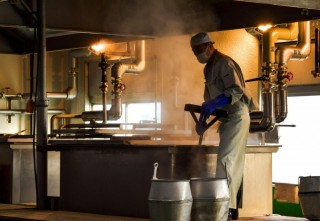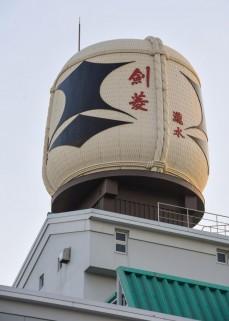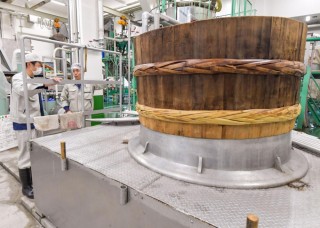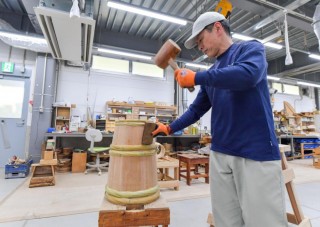Loading
Search
▼ Japan's Oldest Sake Brand Determined To Keep Taste Unchanged
- Category:Gourmet
Although Japan's sake industry faces a crisis with falling domestic consumption, the country's oldest brand, Kenbishi, is unbending in its commitment to the old ways, seeing it as the best guarantor of quality.
In the staff dining room at the brewing facility of Kenbishi Sake Brewing Co, in the city of Kobe, a bottle of sake is set on the table ready for the evening meal. In the kitchen, more sake is warmed in kettles.
"It's all-you-can drink at dinner," said Kenbishi President Masataka Shirakashi, who hopes the recent UNESCO heritage listing of traditional sake-brewing techniques will encourage a revival of the beverage among drinkers in Japan.
Tradition is everything. Brewing always takes place during the winter season. Starting in October, 60 brewers stay onsite for six months, eating together in the dining room. By season's end, they will have consumed around 1,500 bottles of sake, according to Shirakashi.
Across Japan, however, consumption of sake is in decline. Drinking habits are changing, particularly among the young. In 2022, consumption had dropped to less than a third of its peak in the early 1970s, according to data from the National Tax Agency.
"There's no doubt that the sake industry itself is facing a crisis," Shirakashi, 48, told Kyodo News in February.
When the traditional knowledge and skills used in sake-brewing were added to UNESCO's Intangible Cultural Heritage list in December, it offered the industry a moment in the spotlight -- with many now looking to capitalize on the growing interest in sake overseas.
"There's no doubt that the sake industry itself is facing a crisis," Shirakashi, 48, told Kyodo News in February.
When the traditional knowledge and skills used in sake-brewing were added to UNESCO's Intangible Cultural Heritage list in December, it offered the industry a moment in the spotlight -- with many now looking to capitalize on the growing interest in sake overseas.
But with only around 2 percent of Kenbishi's sales coming from exports, Shirakashi sees the listing as an opportunity for people in Japan to take another look at sake.
In a workshop at Kenbishi's brewing facility, the muffled boom of wood hitting wood echoes off the walls as a craftsman circles a barrel made of cedar and uses a wooden block and mallet to hammer into place a bamboo hoop around it.
In a workshop at Kenbishi's brewing facility, the muffled boom of wood hitting wood echoes off the walls as a craftsman circles a barrel made of cedar and uses a wooden block and mallet to hammer into place a bamboo hoop around it.
The craftsman is making a dakidaru, which will be filled with boiling water and plunged into a tank to control the temperature of the yeast starter mix contained within by allowing heat to be released slowly.
While stainless steel and aluminum materials have become the industry norm, Shirakashi argues only wood can maintain the temperature essential to the production of Kenbishi's sake.
A team of three craftsmen makes around 30 dakidaru a year. After each use the barrel's six taga, or bamboo hoops, need replacing. There are 300 dakidaru in circulation at the brewery.
While stainless steel and aluminum materials have become the industry norm, Shirakashi argues only wood can maintain the temperature essential to the production of Kenbishi's sake.
A team of three craftsmen makes around 30 dakidaru a year. After each use the barrel's six taga, or bamboo hoops, need replacing. There are 300 dakidaru in circulation at the brewery.
"Maintenance is a hassle so fewer sake makers are using them," said Shirakashi, who has no qualms bucking this trend. "It's something you'd usually see in a museum."
The dakidaru is just one of the traditional wooden sake-brewing tools and pieces of equipment which Shirakashi said are needed to ensure the taste of Kenbishi's sake remains unchanged.
Kenbishi began making its own traditional wooden equipment in 2009, after dwindling demand made it hard to come by. The brewer now supplies equipment and tools for soy sauce and vinegar makers and for the upkeep of temples and shrines.
The dakidaru is just one of the traditional wooden sake-brewing tools and pieces of equipment which Shirakashi said are needed to ensure the taste of Kenbishi's sake remains unchanged.
Kenbishi began making its own traditional wooden equipment in 2009, after dwindling demand made it hard to come by. The brewer now supplies equipment and tools for soy sauce and vinegar makers and for the upkeep of temples and shrines.
In December, the brewer announced the latest addition to its lineup of traditional equipment with the production of komodaru. The wooden barrels wrapped in straw are a feature of traditional ceremonies and festivals across Japan.
Kenbishi took over two local komodaru makers after the COVID-19 pandemic, during which events were canceled and local businesses were left short of demand and successors.
The manufacturing and use of traditional equipment comes at greater financial cost for Kenbishi. But given its status as Japan's oldest sake brand, Shirakashi said, he feels a greater responsibility to protect it and maintain the taste of Kenbishi sake.
"If we give up on the taste, the brewing methods, and the tools and equipment, Japan will lose all of these things," he said.
Kenbishi says it was founded sometime before 1505 in Itami, Hyogo Prefecture. During the Edo period (1603-1868), the brewery's sake was favored by samurai. According to the brewer, in 1740, it became an official supplier of sake to the shogun.
The Shirakashi family is the fifth to have headed Kenbishi. The current president's great-grandfather moved the company to its present location in Kobe's famous Nada brewing district in 1928.
Despite changes in name and location, the company logo has remained unchanged for over 500 years.
Kenbishi took over two local komodaru makers after the COVID-19 pandemic, during which events were canceled and local businesses were left short of demand and successors.
The manufacturing and use of traditional equipment comes at greater financial cost for Kenbishi. But given its status as Japan's oldest sake brand, Shirakashi said, he feels a greater responsibility to protect it and maintain the taste of Kenbishi sake.
"If we give up on the taste, the brewing methods, and the tools and equipment, Japan will lose all of these things," he said.
Kenbishi says it was founded sometime before 1505 in Itami, Hyogo Prefecture. During the Edo period (1603-1868), the brewery's sake was favored by samurai. According to the brewer, in 1740, it became an official supplier of sake to the shogun.
The Shirakashi family is the fifth to have headed Kenbishi. The current president's great-grandfather moved the company to its present location in Kobe's famous Nada brewing district in 1928.
Despite changes in name and location, the company logo has remained unchanged for over 500 years.
Shirakashi is his family's fourth-generation head of Kenbishi. The family has experience of steering the company through a crisis, while doing what it takes to maintain the taste of its sake.
When post-World War II rice shortages forced brewers into the production of low-quality sanzo-shu -- sake diluted with brewing alcohol or sugar to increase volume -- Shirakashi's grandfather refused to sell it under the Kenbishi name.
Kenbishi was also one of the many breweries in Nada ravaged by the Great Hanshin Earthquake on Jan. 17, 1995, losing all but one of its eight brewing facilities. When it was able to resume brewing, it returned to the same equipment and brewing methods.
Shirakashi follows the policy of his great-grandfather who believed that chasing after trends would always leave the company one step behind. Instead, Kenbishi should be like a stopped clock, always giving the right time twice a day.
"The trends will come back around, so we believe in the sake that our customers have said is delicious," Shirakashi said.
When post-World War II rice shortages forced brewers into the production of low-quality sanzo-shu -- sake diluted with brewing alcohol or sugar to increase volume -- Shirakashi's grandfather refused to sell it under the Kenbishi name.
Kenbishi was also one of the many breweries in Nada ravaged by the Great Hanshin Earthquake on Jan. 17, 1995, losing all but one of its eight brewing facilities. When it was able to resume brewing, it returned to the same equipment and brewing methods.
Shirakashi follows the policy of his great-grandfather who believed that chasing after trends would always leave the company one step behind. Instead, Kenbishi should be like a stopped clock, always giving the right time twice a day.
"The trends will come back around, so we believe in the sake that our customers have said is delicious," Shirakashi said.
- May 12, 2025
- Comment (0)
- Trackback(0)






